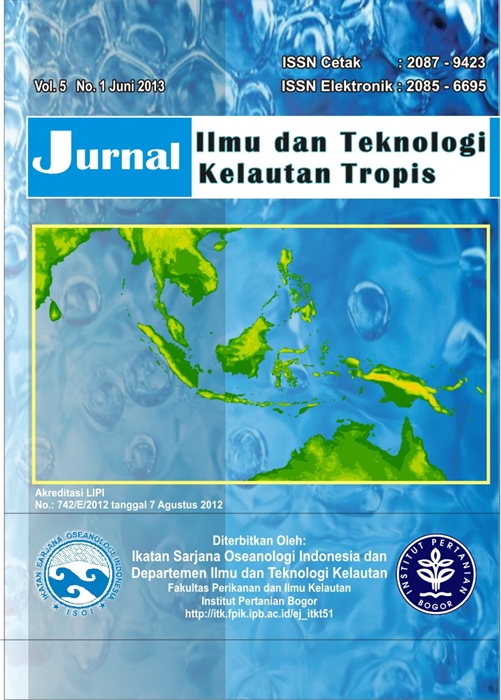DIFFERENCES CONCENTRATION DISTRIBUTION AND SOURCE OF IN ORGANOCHLORINE PESTICIDES IN WATER AND SEDIMENT IN JAKARTA BAY WATERS DURING TRANSITION SEASON
Abstract
Study on the distribution and sources of organochlorine pesticide concentrations in water samples and sediments from the Jakarta Bay was conducted in April 2011 (transition season I) and June 2011 (dry season). The purpose of this study was to determine the distribution of pesticide concentrations in water and sediments and to identify possible sources of organochlorine pesticides. The concentrations of organochlorine pesticides was measured by the GC/ECD (electron capture detection) HP 5890 series II. Concentrations found in the water column during transition I season ranged from 11.596 to 74.338 ng/l (average=41.998 ng/l) and in dry season varied from 4.554 to 19.119 ng/l (average=7.741 ng/l). In sediment samples, concentrations found in transition I season varied from 0.936 to 2.816 ng/g (average=1.782 ug/g), and in dry season about 0.7691 to 7.138 ug/g, (average=2.722 ug/g). In the water column, the average concentration in transition I was higher than that found in dry season, whereas levels in sediment during transition season I was lower. The average levels of pesticides in the water column was higher than those found in sediments. These results suggested that the seasons played a role in the distribution of organochlorine pesticides in the water column and sediments. Source of organochlorine pesticides were suggested from agricultural activities in the mainland Cisadane.
Keywords: organochlorine pesticides, DDT, BHC, Jakarta Bay waters.
Authors
This work is licensed under a Creative Commons Attribution 4.0 International License.
Jurnal Ilmu dan Teknologi Kelautan Tropis i is an open-access journal, meaning that all content is freely available without charge to the user or their institution. Users are allowed to read, download, copy, distribute, print, search, or link to the full texts of the articles in this journal without needing to request prior permission from the publisher or the author.
All articles published by Jurnal Ilmu dan Teknologi Kelautan Tropis are licensed under the Creative Commons Attribution 4.0 International License. This allows for unrestricted use, distribution, and reproduction in any medium, provided proper credit is given to the original authors.
Authors submitting manuscripts should understand and agree that the copyright of published manuscripts is retained by the authors. Copyright encompasses the exclusive rights of authors to reproduce, distribute, and sell any part of the journal articles in all forms and media. Reproduction of any part of this journal, its storage in databases, and its transmission by any form or media is allowed without written permission from Jurnal Ilmu dan Teknologi Kelautan Tropis.


